If you’re planning 2 weeks in Japan with kids in April, you’re in for something pretty special. This is the time when Japan dresses up in its iconic cherry blossoms, the weather’s mostly mild, and the whole country seems to glow with spring magic. Plus, with kids in tow, you want to make sure it’s manageable, fun, and packed with things they’ll actually enjoy—not just museums and temples (though there’s plenty of that too).
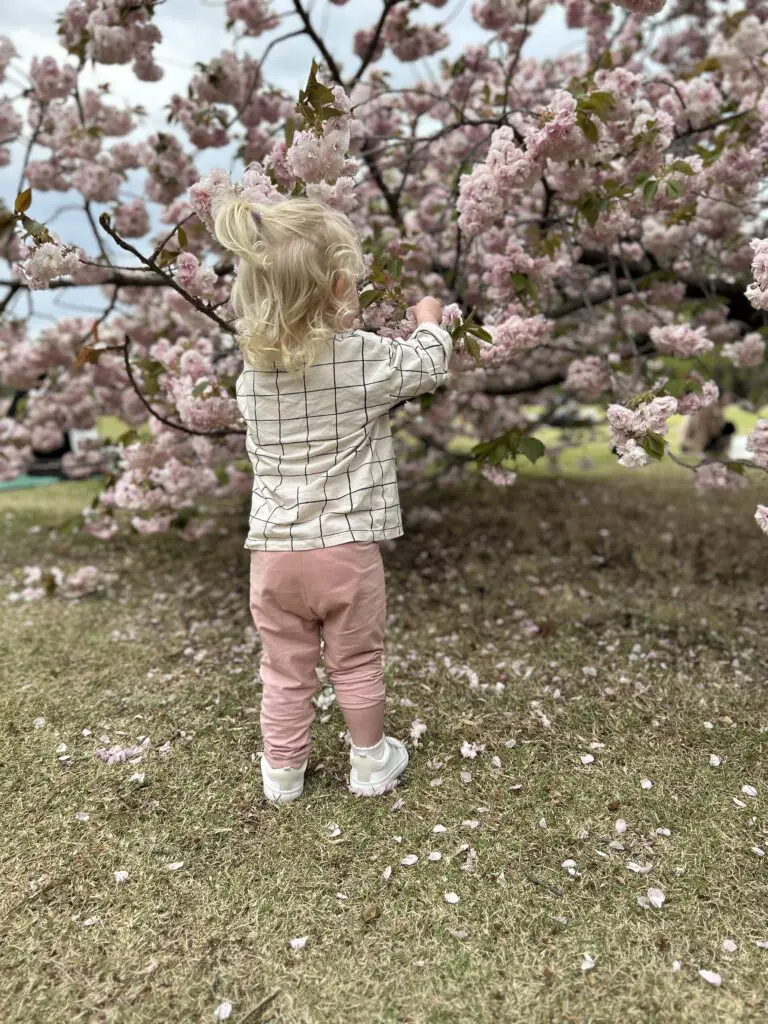
But before you start daydreaming about cherry blossom picnics and futuristic toilets with heated seats (yes, really), there are some important things you need to know to make your family trip run smoothly. Japan is incredibly organised and family-friendly in a lot of ways, but it can throw a few curveballs if you’re not prepared. Here’s everything you need to know about travel essentials, from visas and transport to those quirky little cultural notes that’ll save your sanity.
Table of Contents
Why Visit Japan in April with Kids?
April is pretty much the sweet spot for a family visit. The weather isn’t too hot or cold — you’re looking at daytime temperatures between 13-20°C (so layering is your friend). The famous cherry blossoms (sakura) are in full bloom, turning parks and city streets into pink and white wonderlands. Kids love it because it’s colourful and feels like a fairytale.
On top of that, Japan is one of the safest countries in the world, which is huge when you’re travelling with little ones. You won’t have to worry about traffic or pickpockets, and the public transport system is punctual and clean. The Japanese are incredibly polite and helpful — we had countless strangers offer us umbrellas or help us with directions, which made a huge difference when juggling a toddler and luggage.
Japan Entry Requirements & Paperwork
Japan’s entry rules can feel like a headache, but don’t stress — it’s straightforward if you get your ducks in a row early.
- Visa: For most western travellers (including UK, US, EU), a tourist visa isn’t needed for stays under 90 days.
- Entry Form: You’re required to fill out an online arrival form ahead of time. We didn’t realise this and ended up filling out paper versions on the plane, which was a bit of a faff but no disaster. Tip: check the official government website for the latest and fill it out before flying to save stress.
Getting There & Getting Around
Airports & Arrival
Most international flights land at either Narita Airport or Haneda Airport near Tokyo. Narita is the bigger one but a bit further out (about 90 minutes from central Tokyo). Haneda is closer, more modern, and sometimes easier with kids if you can get flights there.
When you land, Japanese airports are incredibly efficient — bags appear quickly, signage is clear, and there are always staff around who’ll help if you look lost (which you might).
Transport for Families
- Private Taxi: If you’re travelling with toddlers or lots of luggage, pre-book a private taxi with a car seat. We used GetYourGuide, and it was like stepping into a spaceship. The driver was friendly, spoke decent English, and dropped us right at our hotel door.
- Trains & Cards: Japan’s train system is world-class. Grab a Pasmo or Suica card (like an Oyster card in London) to make travel seamless. You tap in and out without queuing for tickets. Heads up: despite Japan’s reputation for being cashless, lots of train stations and small restaurants only accept cash, so carry some yen with you.
- Buggies vs Carriers: Streets and trains are generally stroller-friendly but some stations have stairs and no lifts, so a baby carrier is a great backup. We brought both and used the carrier more than we thought we would.
Money & Spending: Card or Cash?
Contrary to what you might read, Japan is still a cash-heavy society in many places. Small restaurants, local shops, markets, and even some train stations will only accept cash. Plan to withdraw some yen before you go or at ATMs in the airport (7-Eleven ATMs usually accept foreign cards).
Having a Pasmo or Suica card helps with transport and some shops, but don’t rely on cards for everything. Also, don’t try to tip. Japanese culture sees tipping as rude — so just pay the bill and smile!
Family-Friendly Tips & Culture Tid-Bits
- High Chairs Are Rare: Don’t expect many restaurants to have high chairs — we found just two on the entire trip. If you have a toddler who can sit in a buggy, bring one with you.
- Cots are also rare: In bigger hotels and things we found them more common, but especially in more rustic Japanese style rooms, floor sleeping is the ‘done’ thing, and babies are expected to co-sleep with mums!
- Bins Are Scarce: Japan is super clean but there are almost no public rubbish bins. Be prepared to carry your rubbish around until you find a bin or your hotel.
- Mask Wearing: Everyone wears masks all the time, even outside. Don’t be surprised if you feel a bit awkward without one.
- Politeness & Helpfulness: Japanese people go out of their way to help, especially families. We had people offer umbrellas multiple times when it rained and give up their seats for pregnant or carrying parents.
- Toilets: Expect the best toilets you’ve ever sat on — heated seats, bidets, automatic lids, and even music to cover sounds. Totally life-changing.
- Kids’ Cutlery: Most restaurants are good at providing child-friendly bowls, plates, and cutlery even if they don’t advertise it.
- Plastic Food Models: Many restaurants have plastic models of their menu in the window, which helps with ordering if you don’t speak Japanese or if your kids are picky.
- Tattoos: Tattoos are a bit taboo in Japan (especially outside of the big cities) as they are often associated with gangs. In a lot of onsens, tattoos aren’t allowed so make sure to either cover up with some sort of bandage/plaster (depending on the size), or find somewhere that’s tattoo-friendly!
So now that we’ve got all the technical bits out of the way, time for the itinerary…
Days 1–4: Tokyo – Where Tradition Meets Total Madness (But Kid-Friendly, Honestly)
Alright, so you’ve landed, navigated the airport and transport, and now it’s time to dive into Tokyo — the place that can be crazy, yet somehow works for families. You’re going to spend four days here, soaking up parks, techy art, markets, and some seriously good food.
Tokyo might seem overwhelming at first, but trust me, it’s packed with spots that kids and adults alike will love. Here’s the lowdown on how to spend your first four days in Japan with kids in April without losing your mind.
Day 1: Zen Out in Shinjuku Gyoen National Garden (Cherry Blossom Heaven)
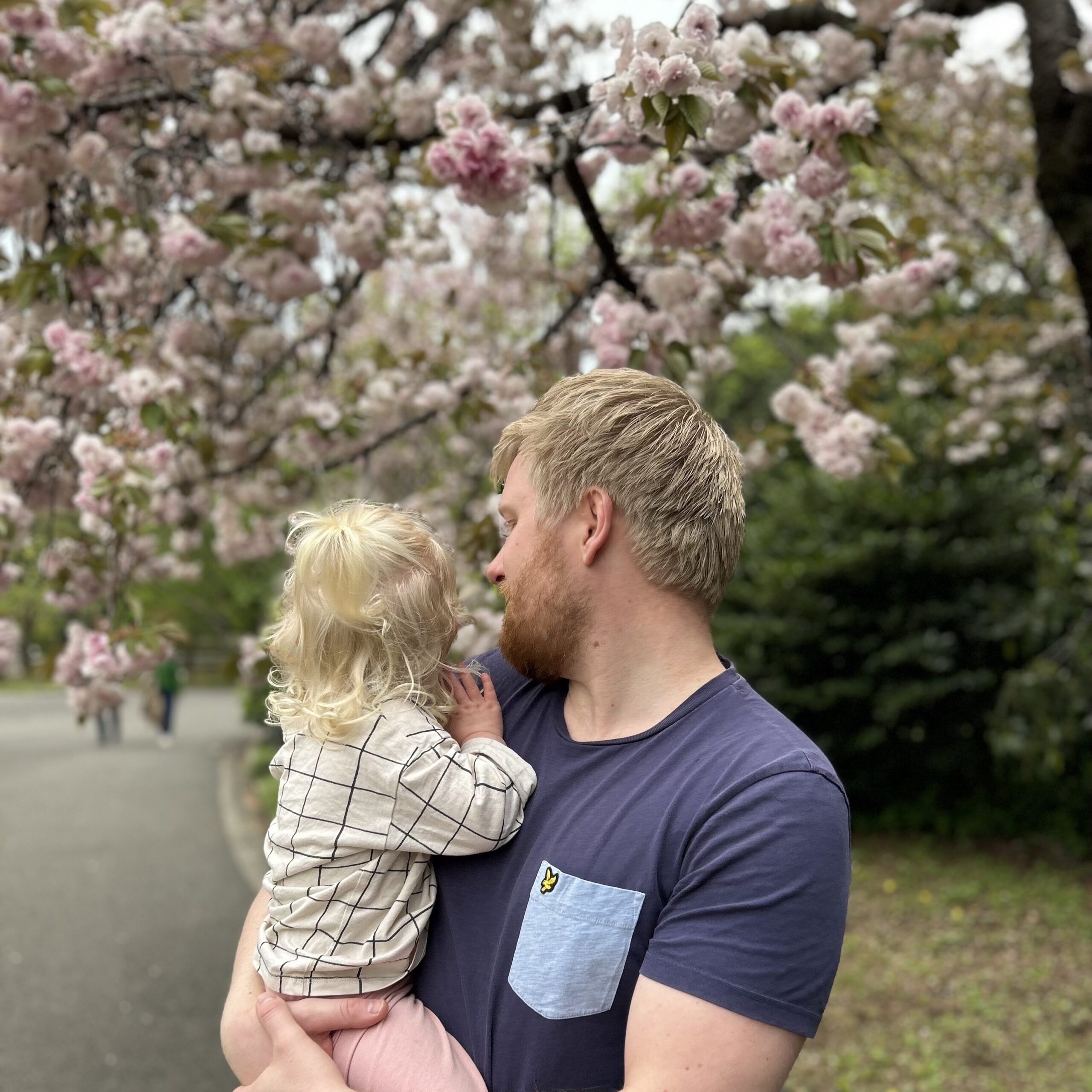
Start easy. After travel, you’ll want somewhere peaceful, and Shinjuku Gyoen is perfect for that. It’s a huge park smack in the middle of the city with sprawling lawns, playgrounds, and those iconic cherry blossoms that’ll have you reaching for your camera every two minutes.
- Entry fee: 500 yen per adult; kids under 15 go free.
- Why it rocks: Plenty of space for the little ones to run wild, plus cafés dotted about for a quick snack.
- Pro tip: No alcohol allowed, so save your picnic beers for later—but grabbing a bento box and sitting under the sakura trees? Pure bliss.
Day 2: Get Lost in TeamLab Borderless – The Digital Playground
If your kids like lights, colours, and running around in spaces that feel like the future, TeamLab Borderless is a no-brainer. This interactive digital art museum is basically a sensory overload—in the best way possible. Your toddler will adore it, and you’ll find yourself snapping way more photos than you thought.
- Buy tickets in advance! Especially for April, when everyone else wants to see it too.
- Kid friendly? Totally. Our toddler was mesmerised and could roam safely.
- Tip: Get there early or later in the afternoon to dodge the crowds.
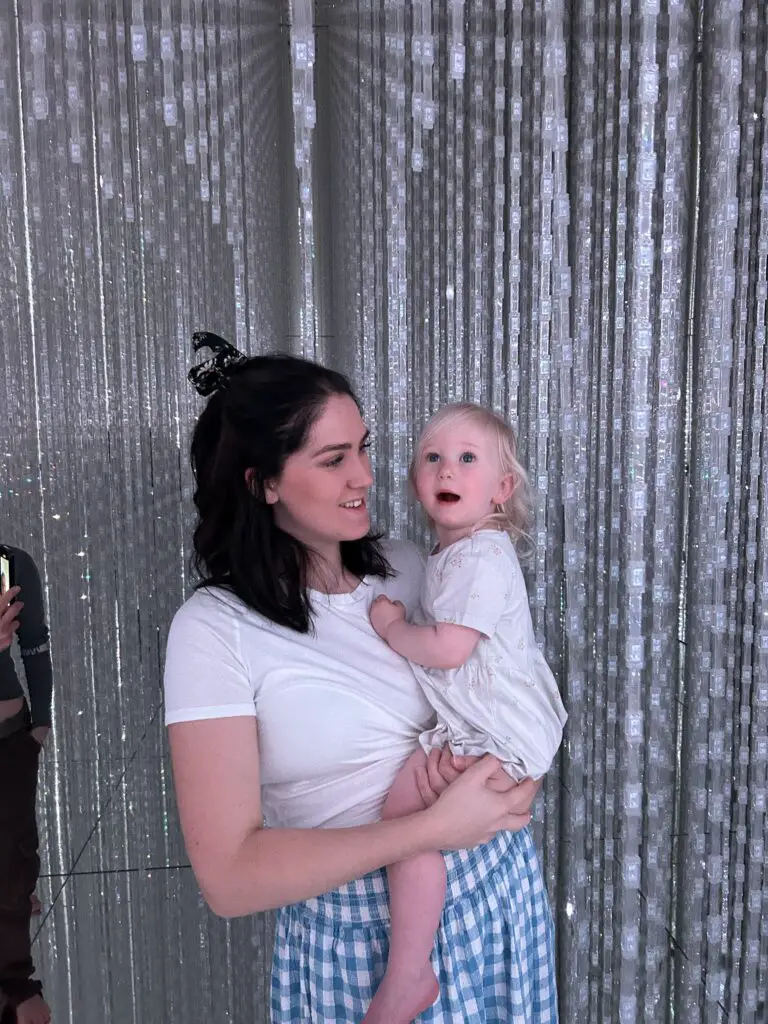
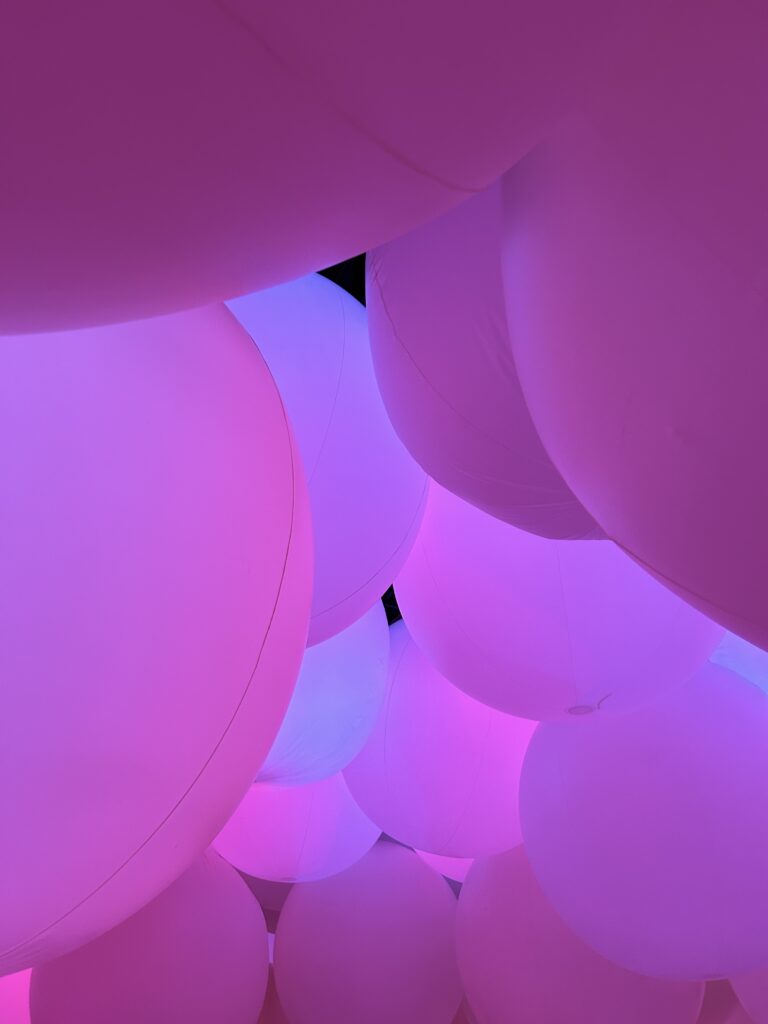
Day 3: The Iconic Shibuya Crossing + Chill Out in Yoyogi Park
You simply cannot visit Tokyo and skip Shibuya Crossing. It’s the world’s busiest intersection, where hundreds of people cross from every direction every few minutes—it’s like watching organised chaos in real time. Kids find it hilarious to watch.
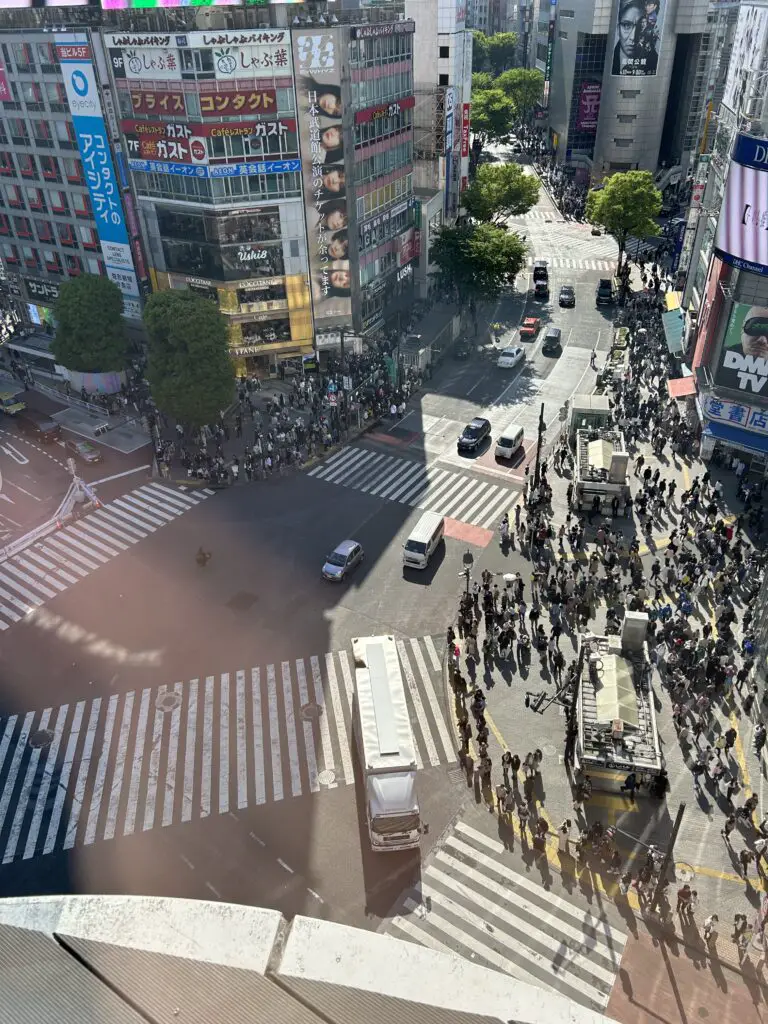
- Best view: Head to the rooftop bar at Magnet by Shibuya109—they’ve got drinks (including non-alcoholic) and sun loungers. Perfect for a breather.
- Nearby: Walk over to Yoyogi Park afterward, a massive green space where your kids can run around freely—and yes, you can drink alcohol here if you want to.
Day 4: Sushi, Strawberries & Sweets at Tsukiji Outer Market
Markets might not scream “toddler-friendly,” but Tsukiji Outer Market is surprisingly welcoming. Beyond the sushi and seafood, there’s a bounty of fresh fruit, including some of the best strawberries we’ve ever eaten, plus matcha ice cream (a hit with both kids and adults).
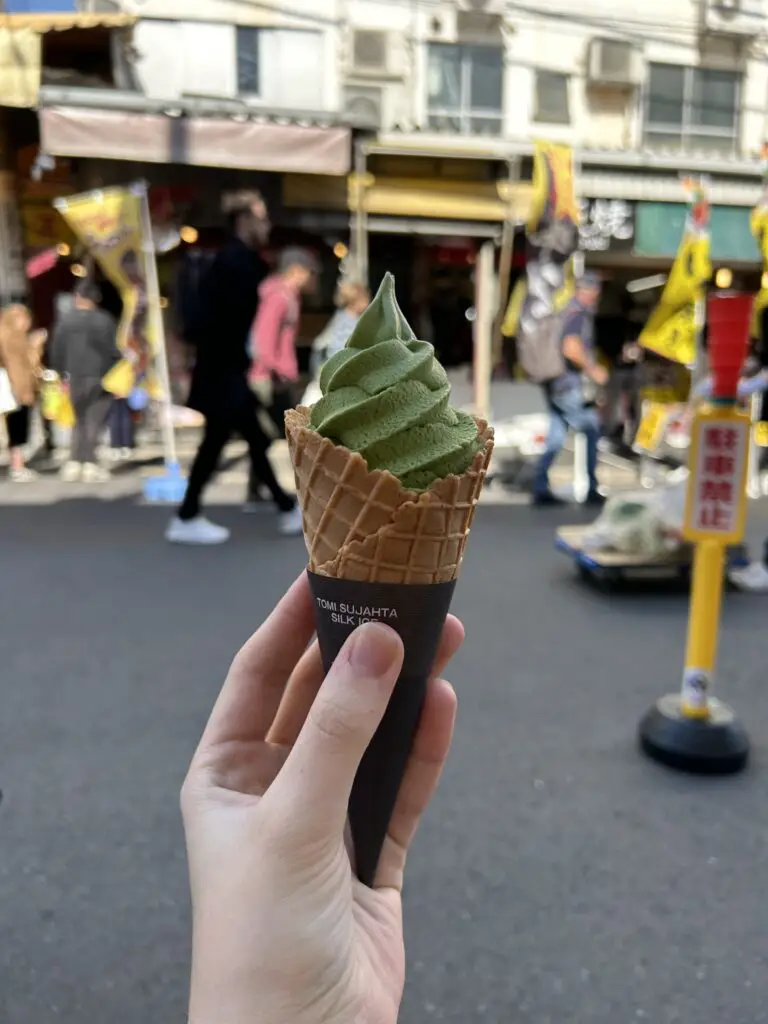
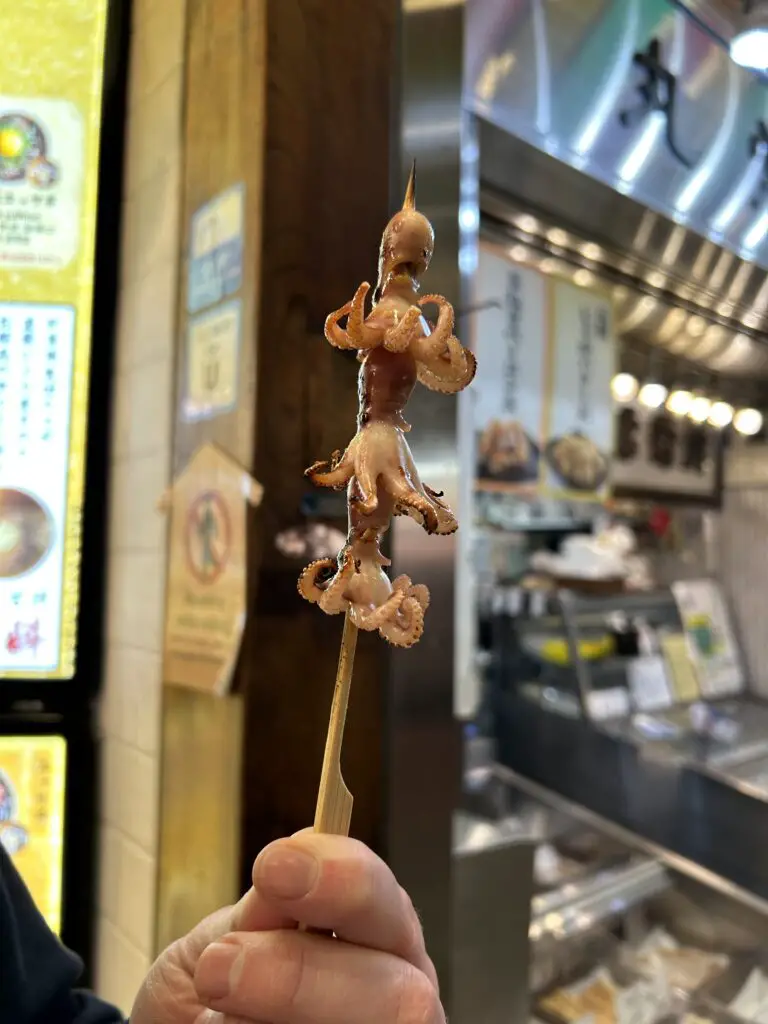
- Timing: Go early to avoid the crowds and to ensure you catch all the stalls before they shut (usually mid-afternoon).
- Eating with kids: Lots of standing eating spots, so you can move around if your little one gets restless.
- Bonus: There’s plenty of non-seafood snacks if your kids are picky eaters.
If you fancy ticking sumo wrestling off your Japan list, Tokyo’s the place to do it — but a word of warning if you’ve got little ones in tow. Some events are surprisingly family-friendly, with a bit more atmosphere and chatter allowed, so the kids can wriggle without getting you death-stared. Others, though, are more traditional, and once the wrestlers step into the ring you could hear a pin drop. It’s all part of the drama, but not ideal if your toddler thinks clapping loudly or narrating what’s happening is part of the experience. Check the vibe before you book, and maybe save the super-serious matches for a grown-ups-only day out.
Where to Eat in Tokyo with Kids
- Ushikoi: Cook your own meat at the table. Fun for grown-ups, good distraction for kids (until they get tired and restless, anyway).
- Madam My: Relaxed Thai-Vietnamese spot with flavours that hit the spot and a laid-back atmosphere perfect for families.
- A Happy Pancake: These pancakes are a bit of a legend—fluffy, soufflé-style delights that are worth the queue. Book ahead or arrive early, because no one likes a hangry toddler.
Tokyo Travel Tips for Families
- Cash is king: Despite the hype, lots of places (including train stations) only take cash, so keep some yen on hand.
- High chairs are rare: Portable boosters are a good shout.
- Public transport: Tokyo’s extensive but not always stroller-friendly—baby carriers are your friends.
- Politeness overload: People will go out of their way to help you, so don’t hesitate to ask if you’re lost or struggling with prams.
That’s your first four days done — Tokyo’s wild, wonderful, and well worth it when you’re doing 2 weeks in Japan with kids in April. Next up: Hakone’s mountains and spas to balance out the city chaos.
Days 5–6: Hakone – Mountains, Hot Springs & Pirate Ships (Yes, Really)
After the city madness, it’s time to breathe. Hakone is about two hours from Tokyo by train, and it’s everything you want after four days of neon and crowds: fresh mountain air, open skies, weird museums, and family-friendly fun. It’s also one of the best places to see Mount Fuji if she decides to show her face.
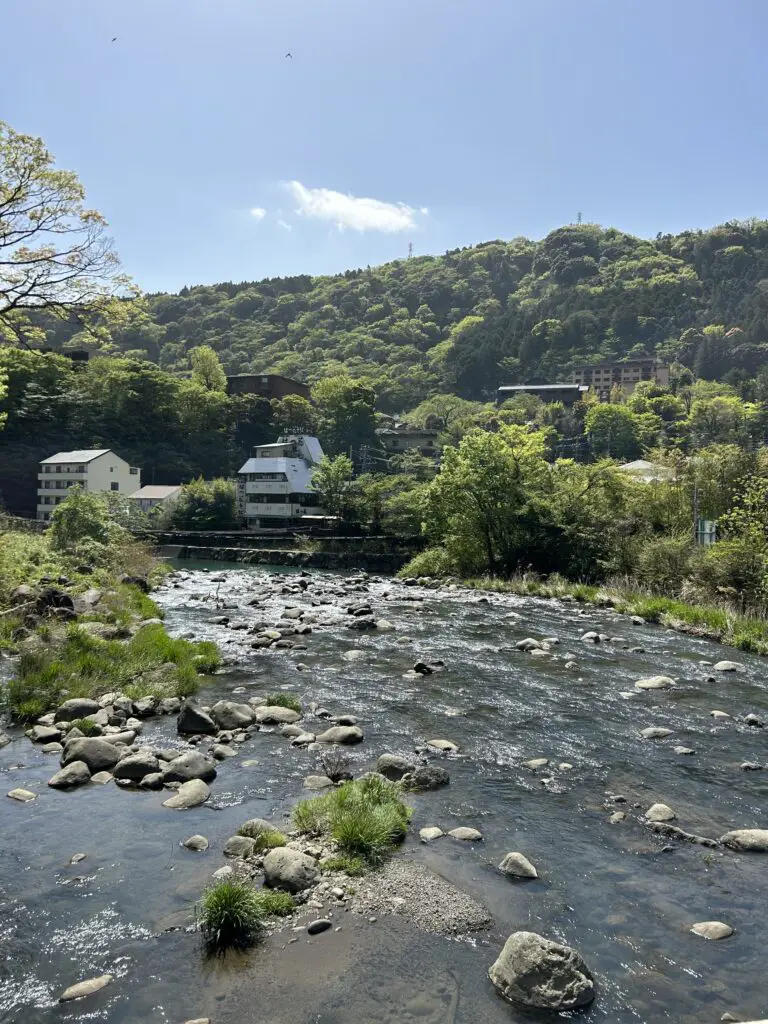
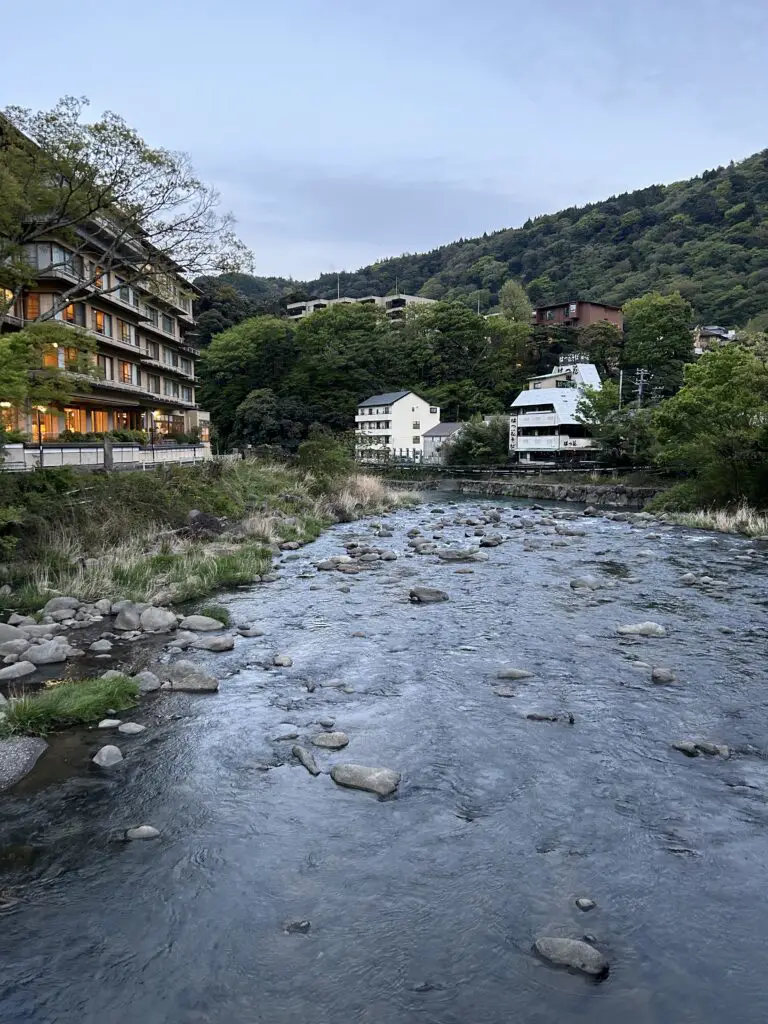
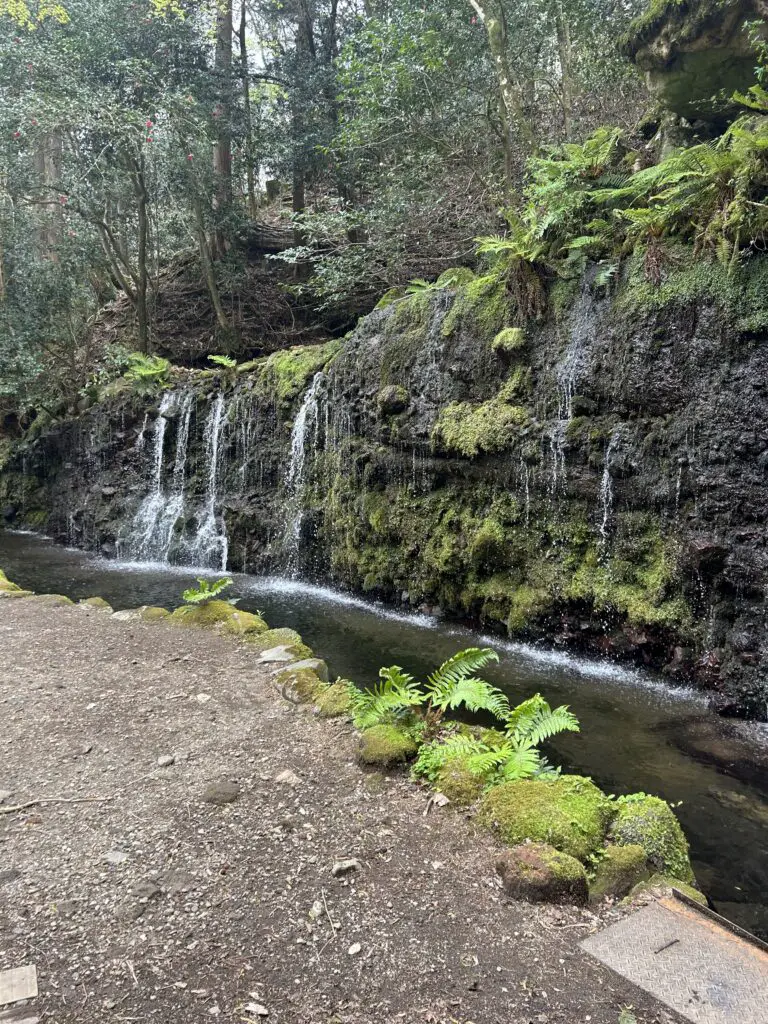
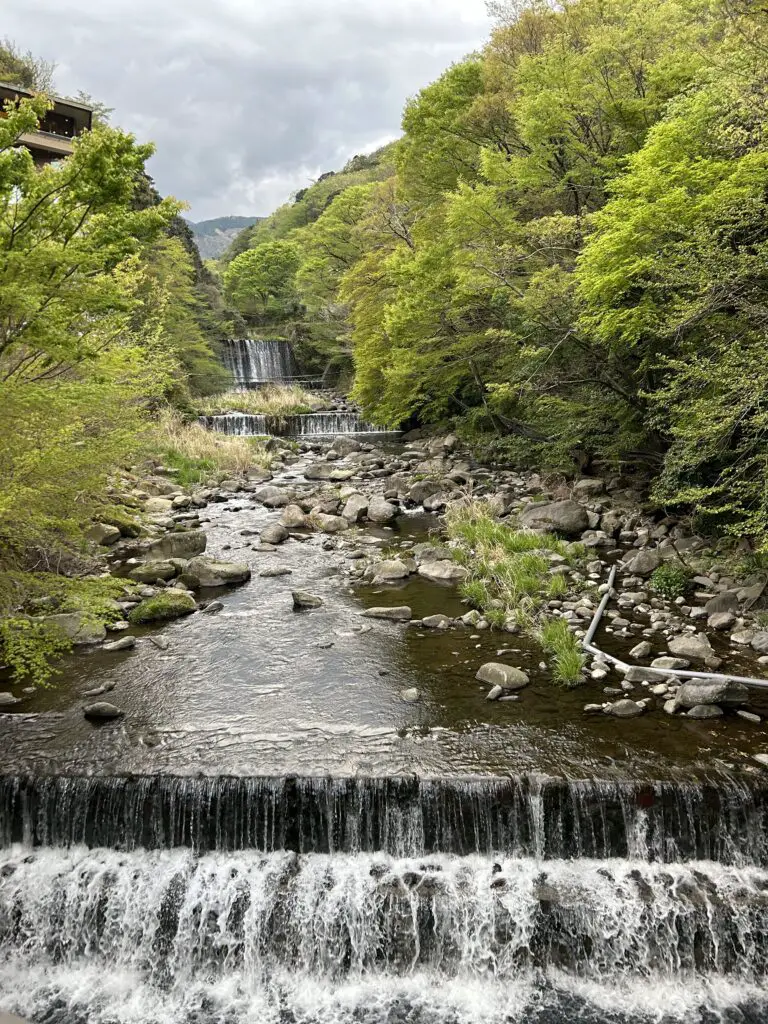
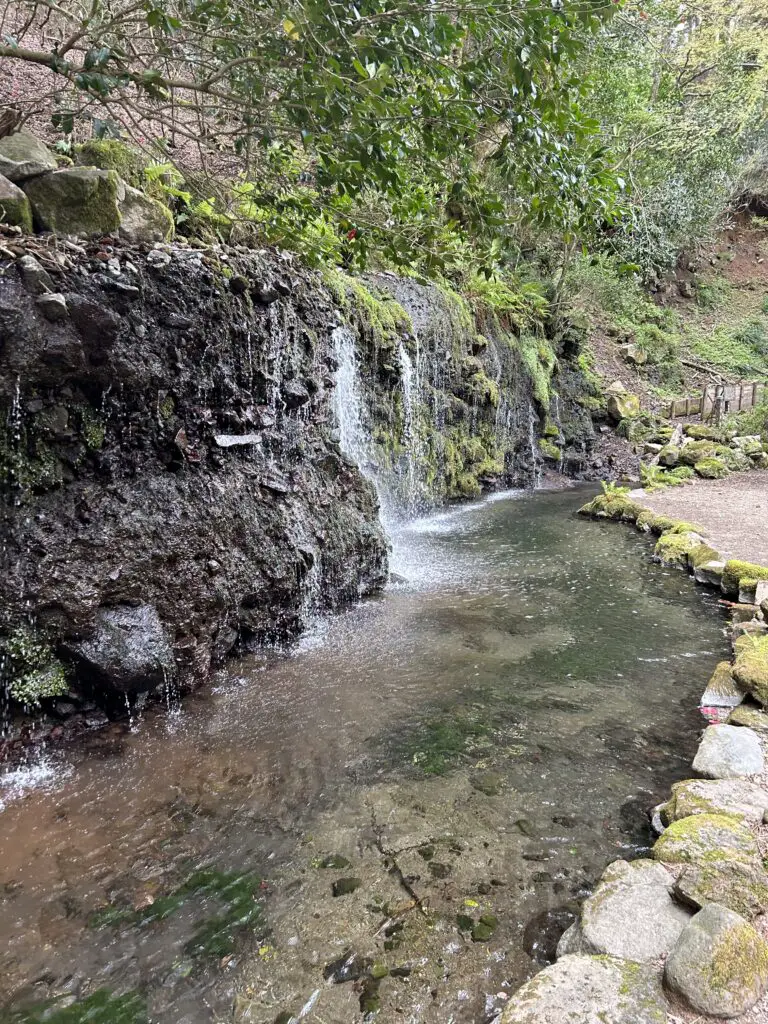
And no, before you ask, you don’t need to spend hundreds on a ryokan with a private onsen. Though you absolutely can, and it was on Scott’s bucket list, so we absolutely did…
How to Get to Hakone from Tokyo
- Train: Easiest way is the Odakyu Romancecar from Shinjuku to Hakone-Yumoto (around 1.5 hours, direct).
- With JR Pass: Take the Shinkansen to Odawara, then transfer to the Hakone Tozan Railway.
- Tip: If you’re bringing a stroller, be warned—some Hakone transport isn’t super accessible. We used a baby carrier for most of it.
Day 5: Open-Air Art & Pirate Boats
You’re probably thinking what do kids care about art? But the Hakone Open Air Museum is honestly brilliant for all ages. It’s not some boring gallery—it’s full of giant sculptures you can climb on, play in, and interact with. There’s a foot bath. There’s a playground. There’s Picasso. What more do you want?
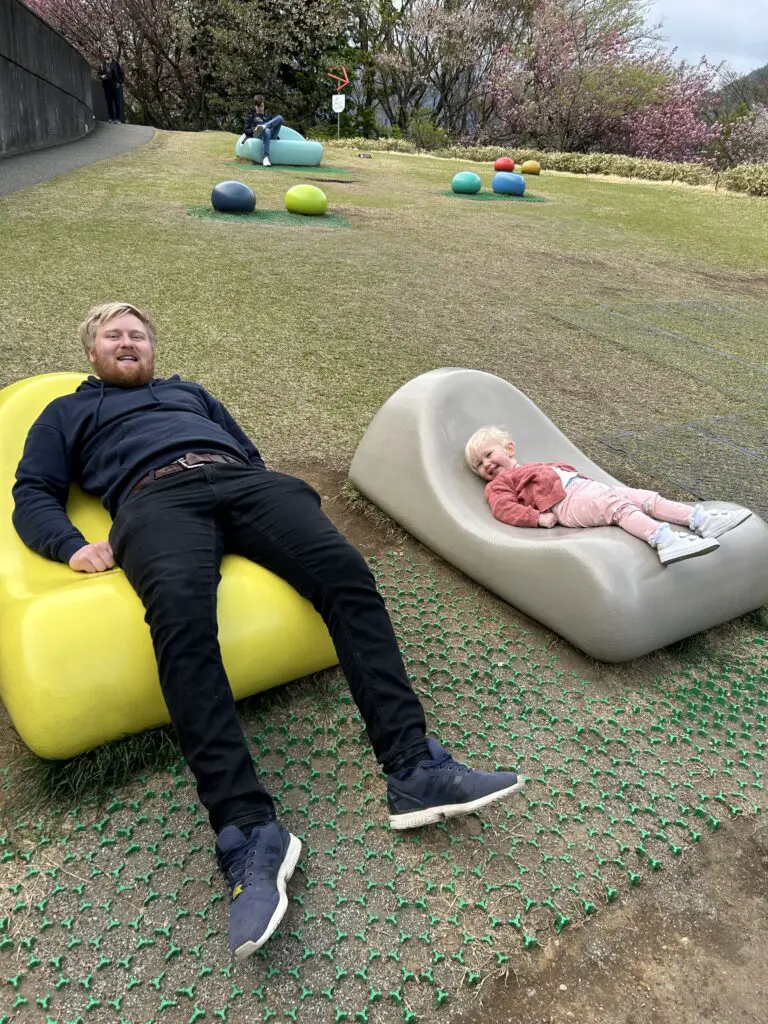
- Cost: Around 1600 yen for adults; kids under 6 are free.
- Best Bit: The netted climbing dome thing that looks like a rainbow exploded inside a soft play centre.
- Food: On-site café has decent sandwiches and cakes (and indoor seating if it’s chilly).
In the afternoon, hop on the Hakone Pirate Ship (no joke—it’s got masts and everything) across Lake Ashi. It’s totally touristy, and kids love it. Plus, if you’re lucky, you’ll get Fuji views in the background. If not, at least the pirate boat makes up for it.
- Included with Hakone Free Pass (which, by the way, is very worth getting).
- Stroller-friendly: Kind of. There are stairs but manageable.
Day 6: Owakudani & Goodbye Hakone
Owakudani is a volcanic valley with steaming vents, sulphur smells, and—you guessed it—black eggs. They’re cooked in the natural hot springs and eating one supposedly adds seven years to your life. Don’t quote me on that. Your kids will think it’s equal parts gross and hilarious.
- Access: Ropeway up from Lake Ashi (also covered by Hakone Free Pass).
- Warning: It stinks. Like proper eggy stink.
- Worth it? Absolutely. It’s bizarre in the best way.
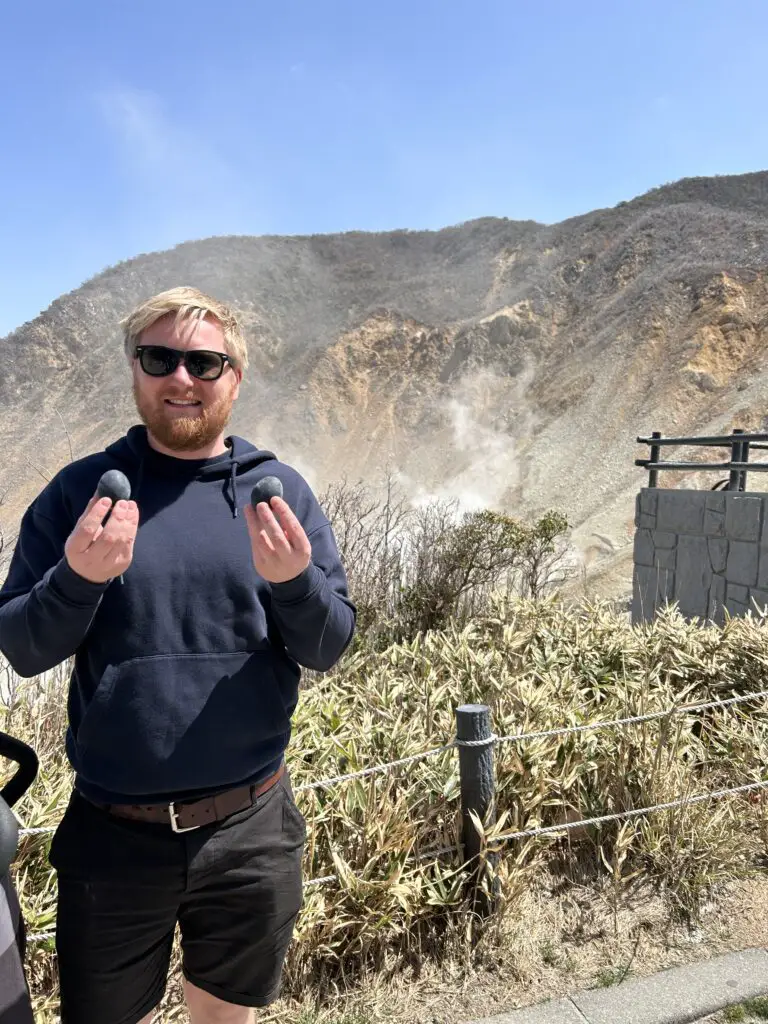
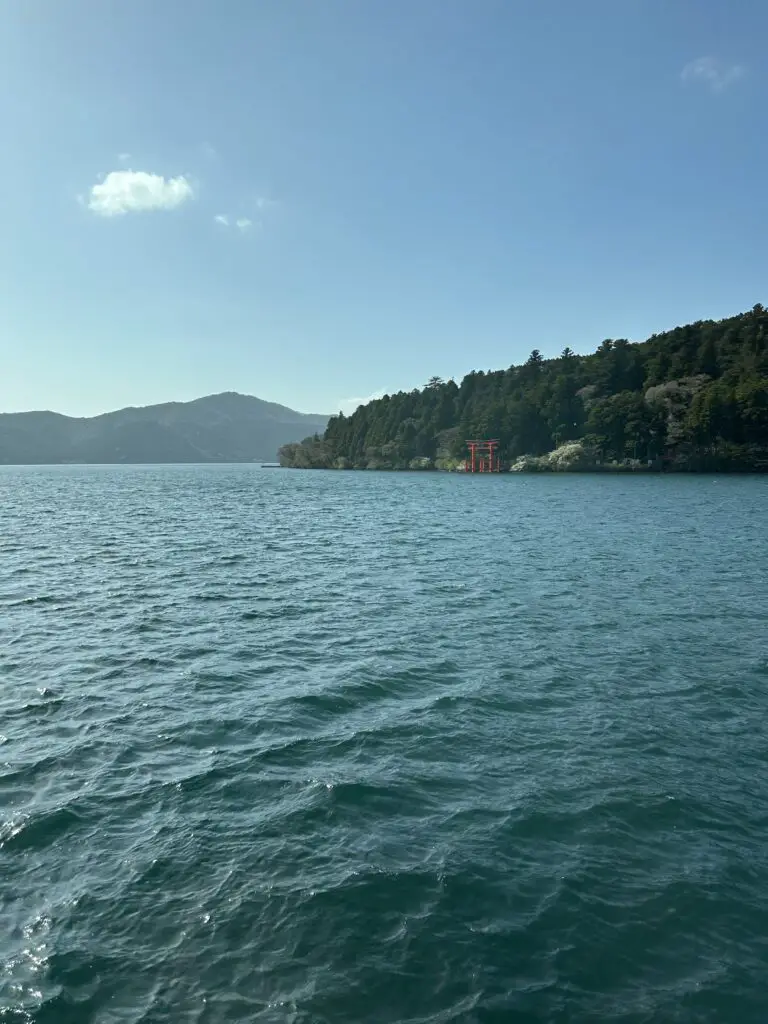
After a bit of eggy volcano fun, you’ll make your way to your next stop: Kawaguchiko, for those picture-perfect Fuji views.
Where to Stay in Hakone with Kids
- Mount View Hakone – Mid-range, family rooms, onsen access, very Japanese vibes but kid-welcoming.
- Emblem Flow – Trendy hostel-style with private rooms, good value, and friendly to families.
- Ryokan or not? If your kids sleep well, go for it. If they don’t… maybe hold off on the traditional tatami setup unless you’re mentally prepared.
Hakone Tips for Families
- Weather changes fast – Layers are key. One minute it’s sunny, the next you’re in a cloud.
- Public transport shuts down early – Don’t get caught stranded.
- Hot springs with kids – Not all onsens allow kids, so check ahead. Many don’t allow swim nappies or kids under a certain age. Private baths are a safer bet.
- Snacks aren’t everywhere – Bring your own just in case, especially if you have picky eaters!
And that’s Hakone done – a perfect mountain break in the middle of your 2 weeks in Japan with kids in April. Next stop: the place you’ve probably seen a million times on Instagram – Kawaguchiko.
Days 7–8: Kawaguchiko – Lake Views, Fuji-San & Cosy Countryside Vibes
Kawaguchiko is one of the best places to see Mount Fuji, especially in spring. Picture this: cherry blossoms framing the lake, Mount Fuji glowing in the background, and your toddler happily chasing ducks. It’s peaceful, stunning, and makes you want to quit your job and move to Japan to run a guesthouse.
It’s also much more kid-friendly than you’d think for somewhere so scenic. There’s space to run around, fun attractions, and loads of places for low-key exploring. The weather in April was cool but not cold — jacket weather, but nothing extreme.
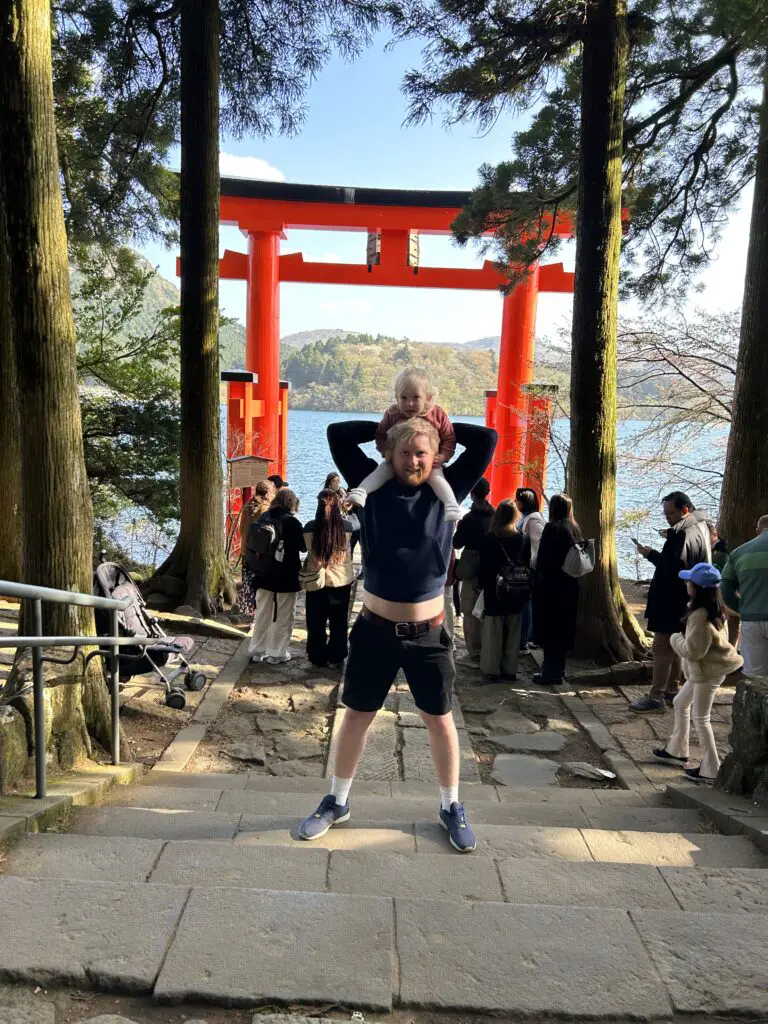
Getting to Kawaguchiko from Hakone
You’ve got two main options:
- Train: From Odawara, take the JR Tokaido Line to Kozu, then the JR Gotemba Line to Gotemba, then a bus to Kawaguchiko. Sounds like a faff, but it works.
- Bus: There are direct highway buses, but not frequent. If you can time one right, it’s the easiest.
With a toddler, it’s a bit of a mission (especially with bags), but doable. Bring snacks. Lots of them.
Day 7: Arrival & Exploring the Lake
Once you’ve arrived and checked in, stretch your legs with a walk around Lake Kawaguchi. You don’t need a plan — just wander. There are cherry blossoms lining the lakeside paths in April, and you’ll get those postcard Fuji views (on a clear day). Stop at little jetties, playgrounds, and cafes along the way.
Great kid-friendly stops:
- Oike Park: Nice green space right by the lake. Has a playground and plenty of space to run.
- Yagizaki Park: Cherry blossom heaven in April.
- Konohana Museum: Quirky, Ghibli-esque art and illustration museum. Weird but delightful.
For dinner, lots of places here close early — we grabbed bento boxes and snacks from the Lawson convenience store and had an in-room picnic. With a baby or toddler, honestly, it’s kind of ideal.
Day 8: Ropeways, Views & Chill Time
In the morning, hop on the Mt. Fuji Panoramic Ropeway (formerly the Kachi Kachi Ropeway). It’s a short cable car ride with sweeping views of the lake and (hopefully) Mount Fuji. At the top, there’s a small trail and some funny statues based on a local folktale involving a tanuki (raccoon dog) and a rabbit who, let’s say, has violent tendencies. Kids will probably be more into the views.
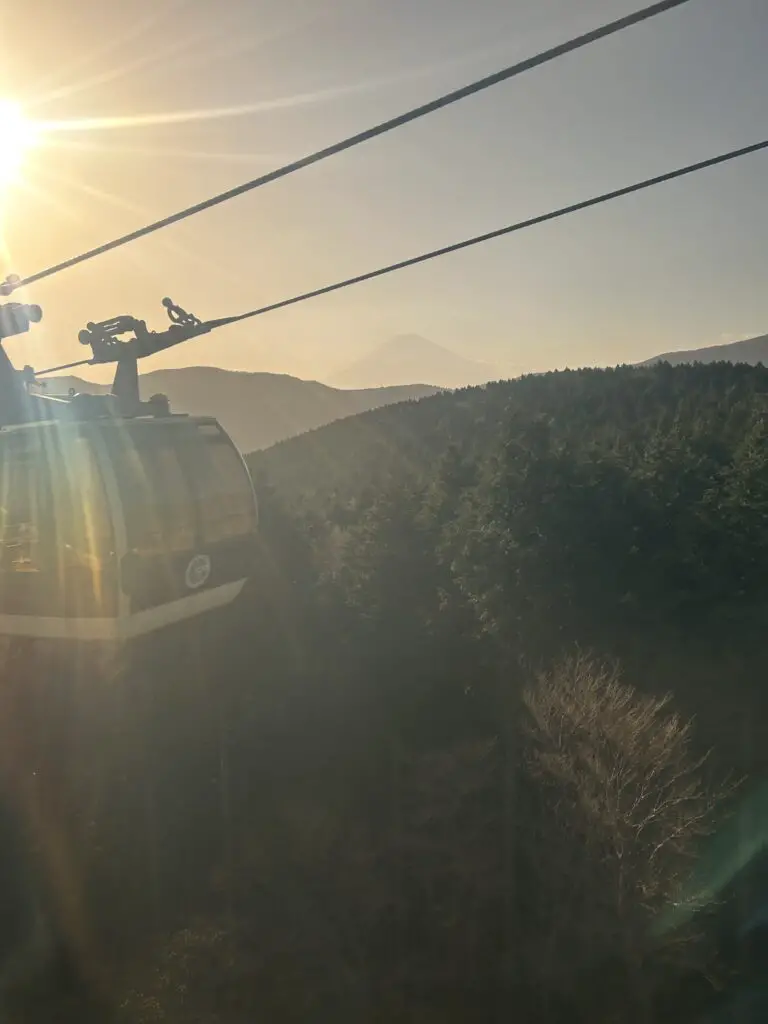
- Cost: Around 900 yen return for adults. Under-6s free.
- Tip: Go early before it gets busy, especially on weekends.
After that, take it easy. Kawaguchiko’s charm is in just being there. Walk the lake path again, get some sakura soft cream, browse the tourist shops, or sit by the water and soak it all in while your kid naps in the buggy.
Where to Stay in Kawaguchiko with Kids
We booked a Japanese-style guesthouse with lake views and a small kitchenette. Here’s what worked:
- Shuhokaku Kogetsu – Beautiful lakefront ryokan with views from the baths. More high-end, but wow.
- Fujizakura Inn – Budget option near town, clean, simple, great if you just need a bed.
- Fuji View Hotel – Mid-range, big rooms, perfect gardens for kids to run around, and great Fuji views.
Family Travel Tips for Kawaguchiko
- Fuji is unpredictable – Just because it’s clear in the morning doesn’t mean it’ll stay that way. Prioritise Fuji-viewing activities early in the day.
- Convenience store meals are a lifesaver – Seriously. There’s zero shame in 7-Eleven dinners in Japan (although you can’t beat a ramen!)
- Transport is sparse – Buses are limited, and taxis are expensive. We mostly walked, or timed our day around the limited bus schedule.
- Spring blossoms – Mid to late April is ideal for sakura here, depending on the year.
And just like that, you’re halfway through your Japan adventure. Kawaguchiko is the peaceful, photogenic breather before you dive into the cultural heart of the trip: Kyoto.
Days 9–14: Kyoto, Nara, Kobe & Osaka – Culture, Temples & Surprisingly Good Playgrounds
You’re now in Kyoto — Japan’s old capital, full of ancient shrines, geishas, and quiet lanes that somehow survive the crowds. It’s stunning, historic, and feels completely different from Tokyo.
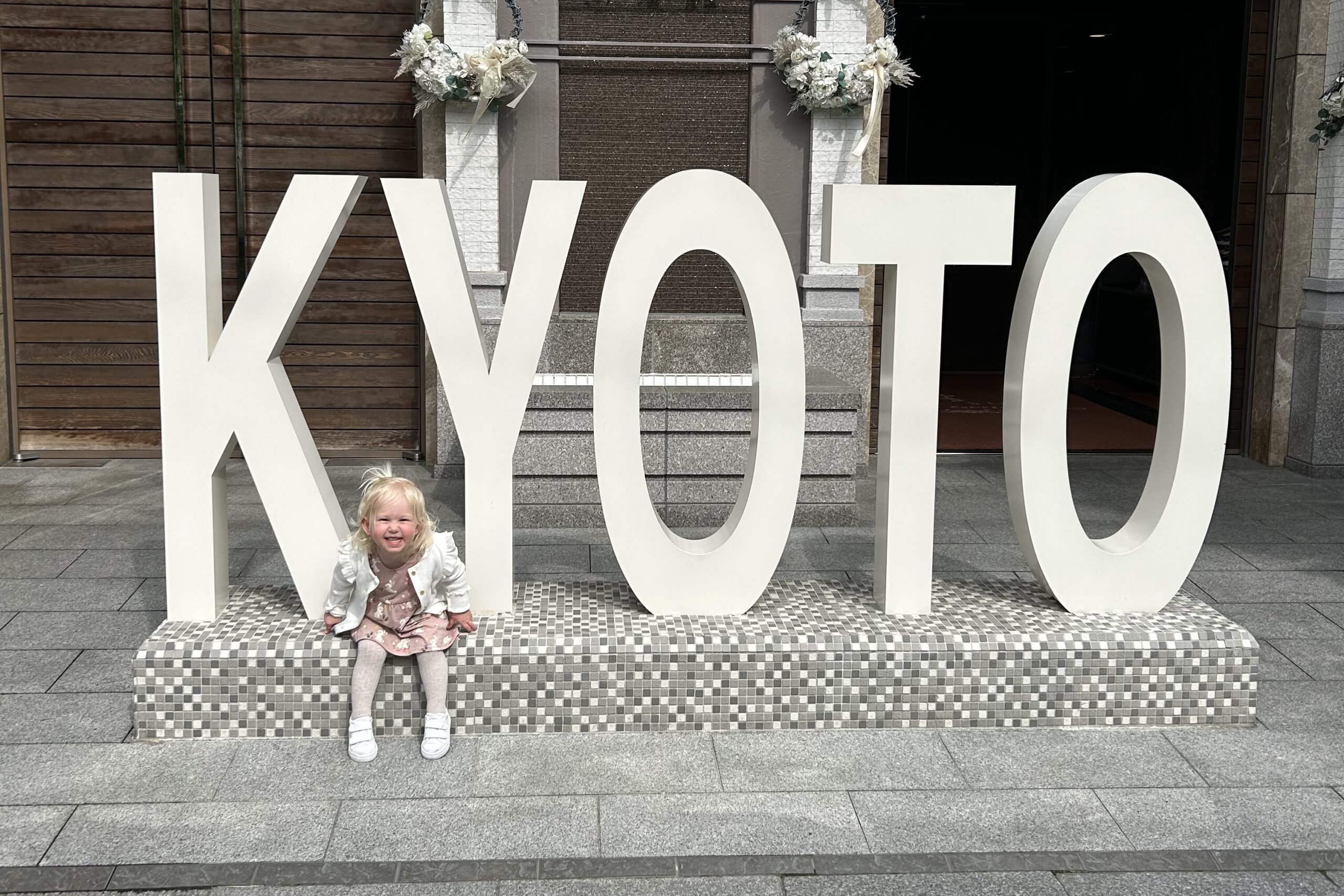
Six nights here might sound like a lot, but with kids it’s ideal. You’ll want slower days, room for detours, and time to see nearby spots like Nara and Kobe without rushing. We based ourselves in Kyoto the whole time and did day trips — no more hotel-hopping. Bliss.
Day 9: Travel to Kyoto & First Impressions
From Kawaguchiko, the journey to Kyoto takes around 4–5 hours with transfers. We opted for:
- Bus to Mishima Station, then
- Shinkansen (bullet train) from Mishima to Kyoto (with a toddler sleeping in the sling, living the dream).
When we arrived, we headed straight to our Kyoto base — a machiya-style Airbnb in a quiet neighbourhood just south of the city centre. Tatami mats, futons, low tables.
No pressure on day 1. We did a gentle walk along the Kamo River, stopped at a playground, and picked up snacks from the local Family Mart. You’ll be tired — embrace the slower pace.
Day 10: Fushimi Inari & Kyoto’s Best Playground
Yes, we did the famous Fushimi Inari shrine — the one with all the red torii gates. But here’s the thing: you do not have to hike all the way to the top. We walked for a bit before our toddler’s little legs got tired, took some photos, and then turned around just when it started to rain. At the Fushimi Inari Shrine, you can buy small wooden plaques called ema. These are little hanging tablets where visitors write their wishes, prayers, or messages—usually in Japanese—and then hang them up at the shrine or take them home. It’s a beautiful tradition believed to help those wishes come true. We took ours home with us and it still sits on our shelf with our other travel memorabilia (although I can tell you now that the wishes didn’t come true for us!).
Top tips:
- Go early (before 9am) to beat the crowds.
- Bring snacks and water — no vendors once you’re on the trail.
- Carrier not buggy-friendly — stairs galore.
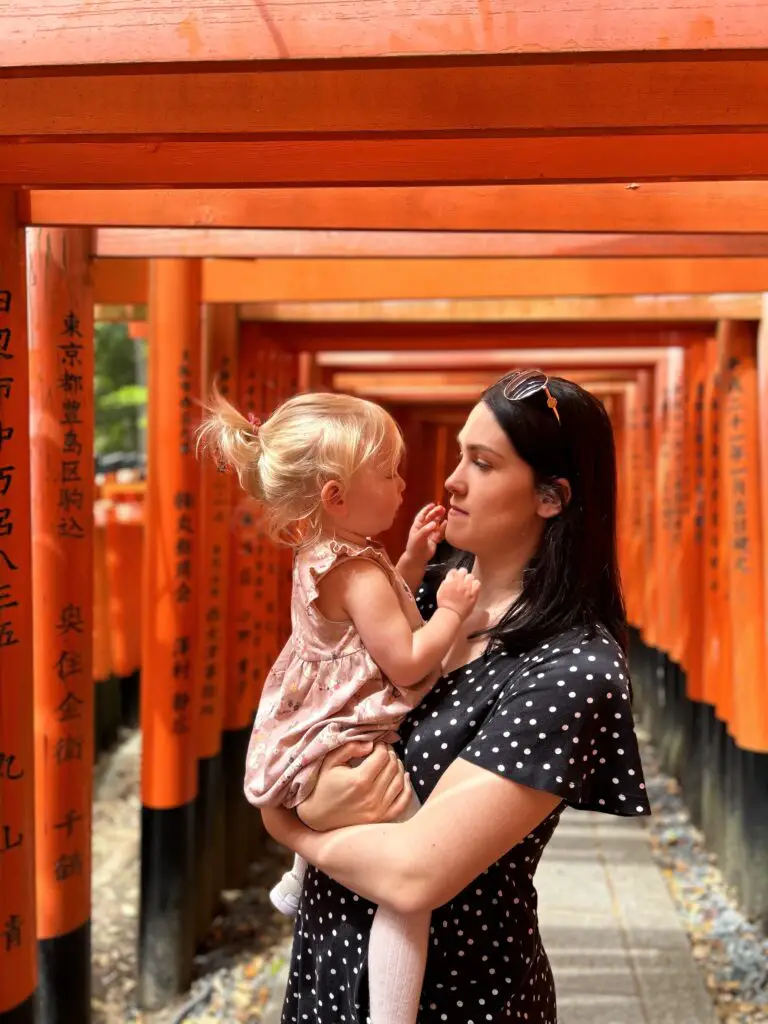
After the shrine, you can take a cab to Kyoto Railway Museum — genuinely brilliant for kids (and train nerds). Real locomotives, simulators, and a huge open space for running around. There’s also Umekoji Park just next door. It has a great playgrounds for little one’s to burn off some energy — huge slides, sandpit, and even a splash zone.
Day 11: Arashiyama & Monkey Park
Arashiyama is a bamboo-grove-and-temple dream — but also has a surprising amount to offer families.
Here’s what we did:
- Walked through the Bamboo Grove early in the morning — peaceful and magical.
- Iwatayama Monkey Park: Hike up a hill (25 mins uphill — not for buggies), and you’ll find a sanctuary where monkeys roam freely. Kids can feed them from a caged hut (you inside, monkeys out). Great views of Kyoto from the top.
- Arashiyama Park: More chill playground space and picnic spots.
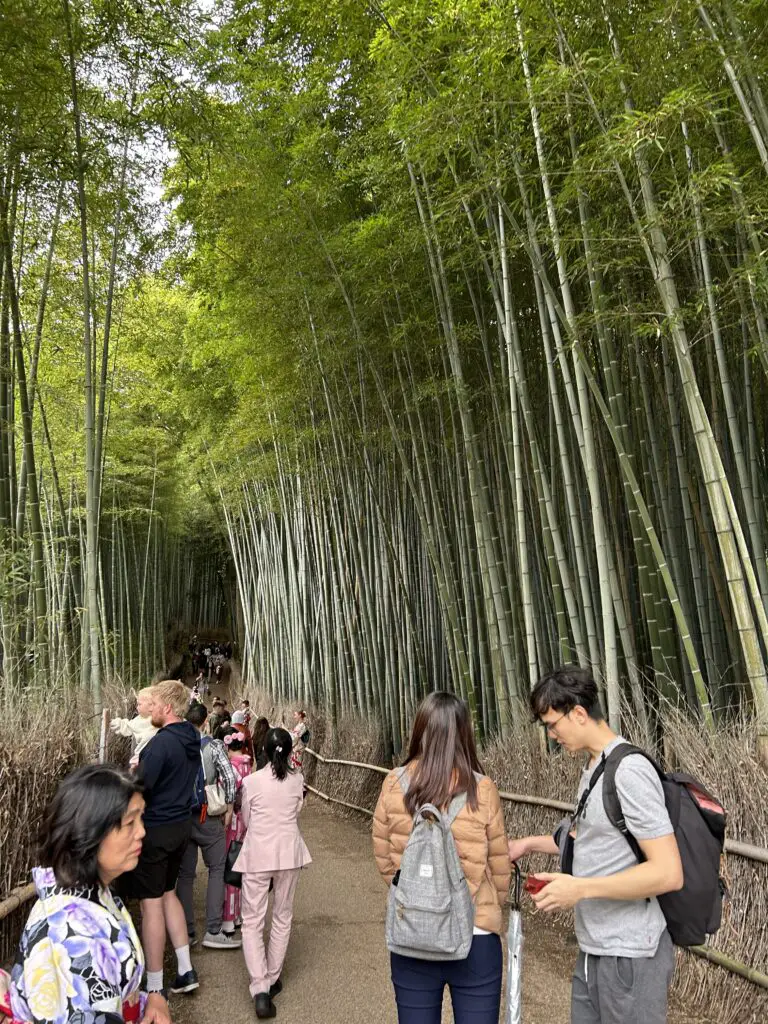
Lunch at % Arabica coffee (good takeaway) or one of the riverside cafes.
If you’ve got extra energy, check out Tenryuji Temple’s gardens or rent a rickshaw (pricey but fun if your kids love novelty transport).
Day 12: Nara Day Trip – Yes, the One With the Deer
From Kyoto Station, hop on a JR train to Nara — around 45 minutes.
First stop: Nara Park, where over 1,000 free-roaming deer beg for deer biscuits (available everywhere). Some bow. Some headbutt. All will chase your toddler if snacks are visible.
It’s chaotic, hilarious, and oddly beautiful.
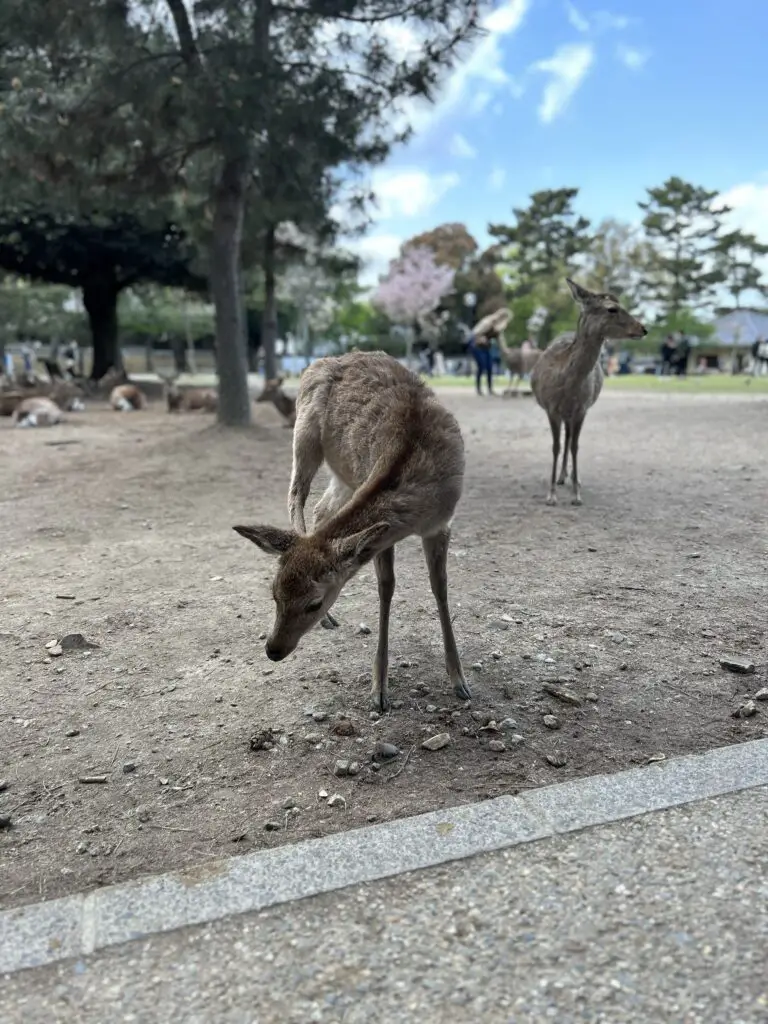
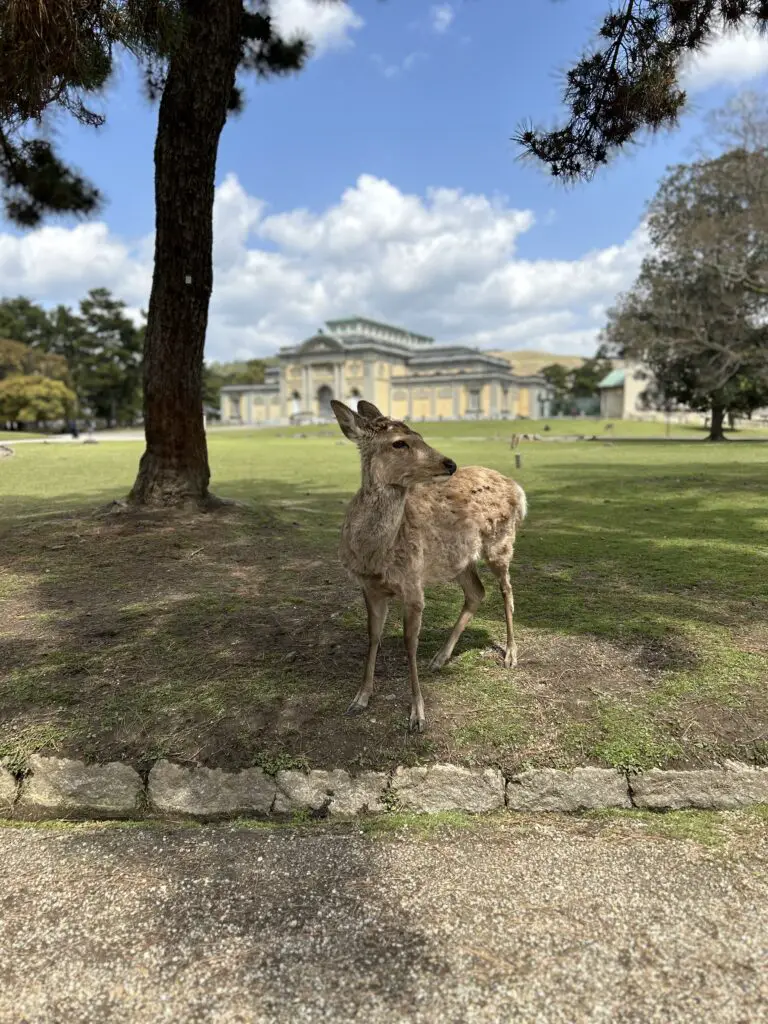
Also worth seeing:
- Todai-ji Temple: Houses the world’s largest bronze Buddha. Impressive even for littles.
- Isuien Garden: Less visited, calm and stroller-friendly.
We brought a picnic and spent a lot of the day just wandering. There’s a nice playground near the Nara National Museum too.
Day 13: Gion & Higashiyama Wanderings
Today’s the more cultural Kyoto day — but still fun for families.
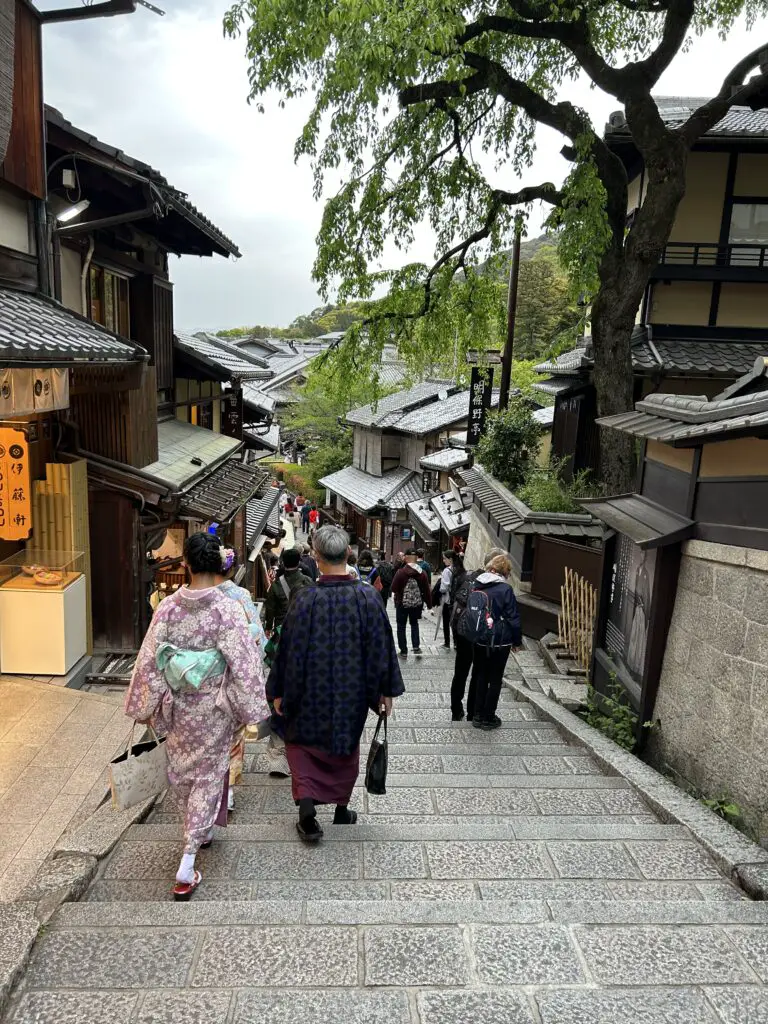
We explored the Higashiyama District, full of preserved lanes, traditional shops, and snack stops. You can wander through Sannenzaka and Ninenzaka streets, visit Kiyomizu-dera Temple (lots of steps but beautiful), and stop at the Ryozen Kannon statue (less touristy, very peaceful).
Late afternoon, we headed into Gion, hoping to spot a geisha (spoiler: we did not). But we did find an excellent matcha ice cream and watched a kimono rental photoshoot, which our toddler found way more entertaining.
Dinner in Kyoto was often bento or ramen from small local places — simple, quick, and delicious. Honestly, some of the best food we had was from stations and convenience stores.
Day 14: Kobe or Osaka (Optional Day Trip)
If you’re itching for one last excursion, you’ve got two great options:
- Kobe: Under an hour by train. Known for its food (Kobe beef, obvs), but also has a lovely harbour area with a Ferris wheel, Kobe Animal Kingdom, and Kidzania if you’ve got older kids.
- Osaka: Already on your route, especially if you’re flying out from Kansai. Famous for street food, shopping, and the epic Osaka Aquarium.
We did Kobe as a final day out — it was pretty rainy this day so we walked the harbour briefly, but found shelter in an indoor play-area, ate some Kobe Beef and headed back ‘home’ for the afternoon.
Bonus: Where to Stay in Kyoto with Kids
Accommodation here was our most comfortable of the trip. We liked:
- Airbnb in a residential area – Gave us space, kitchen, and washing machine. Life saver.
- Hotel Granvia Kyoto – Right above the station. Super convenient.
- Kyoto Yura Hotel – MGallery – Stylish, central, and surprisingly family-friendly.
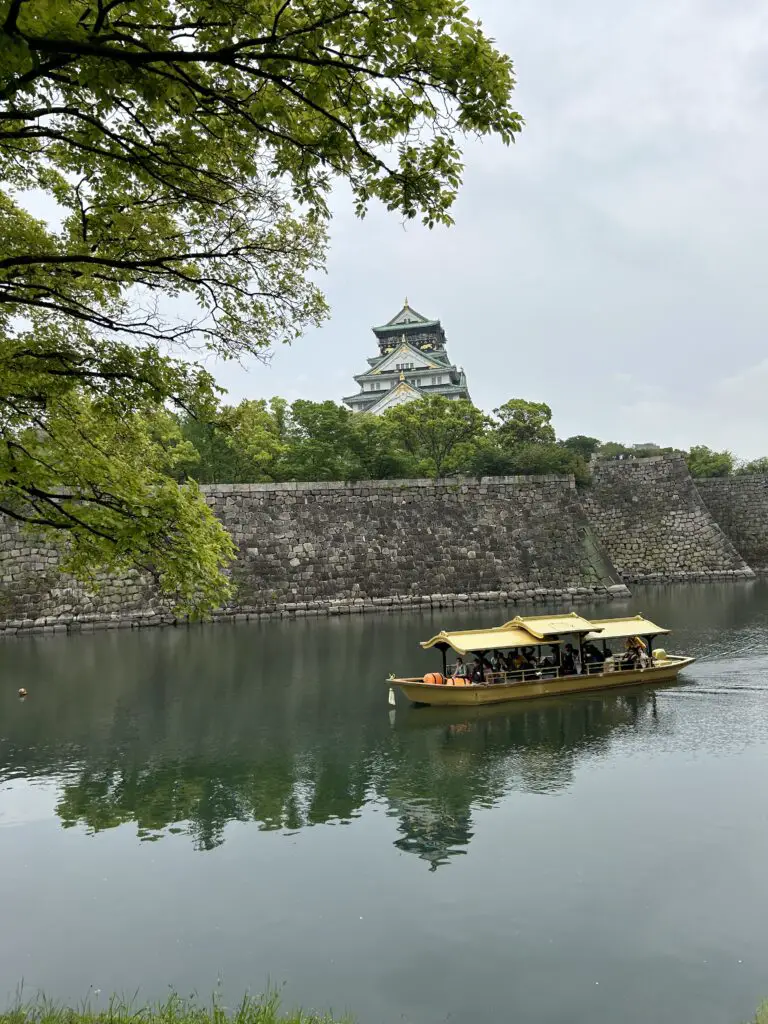
Final Thoughts: Is 2 weeks in Japan with Kids in April Worth It?
Absolutely, yes.
Is it full-on? Also yes.
But April is magical — the blossoms, the weather, the people (yes I know they will be the same the whole year round but still…). We had the most amazing trip to Japan with our toddler, and from what I’ve seen on social media, everyone has the same amazing experience there with children! If you’re thinking of going, GO!
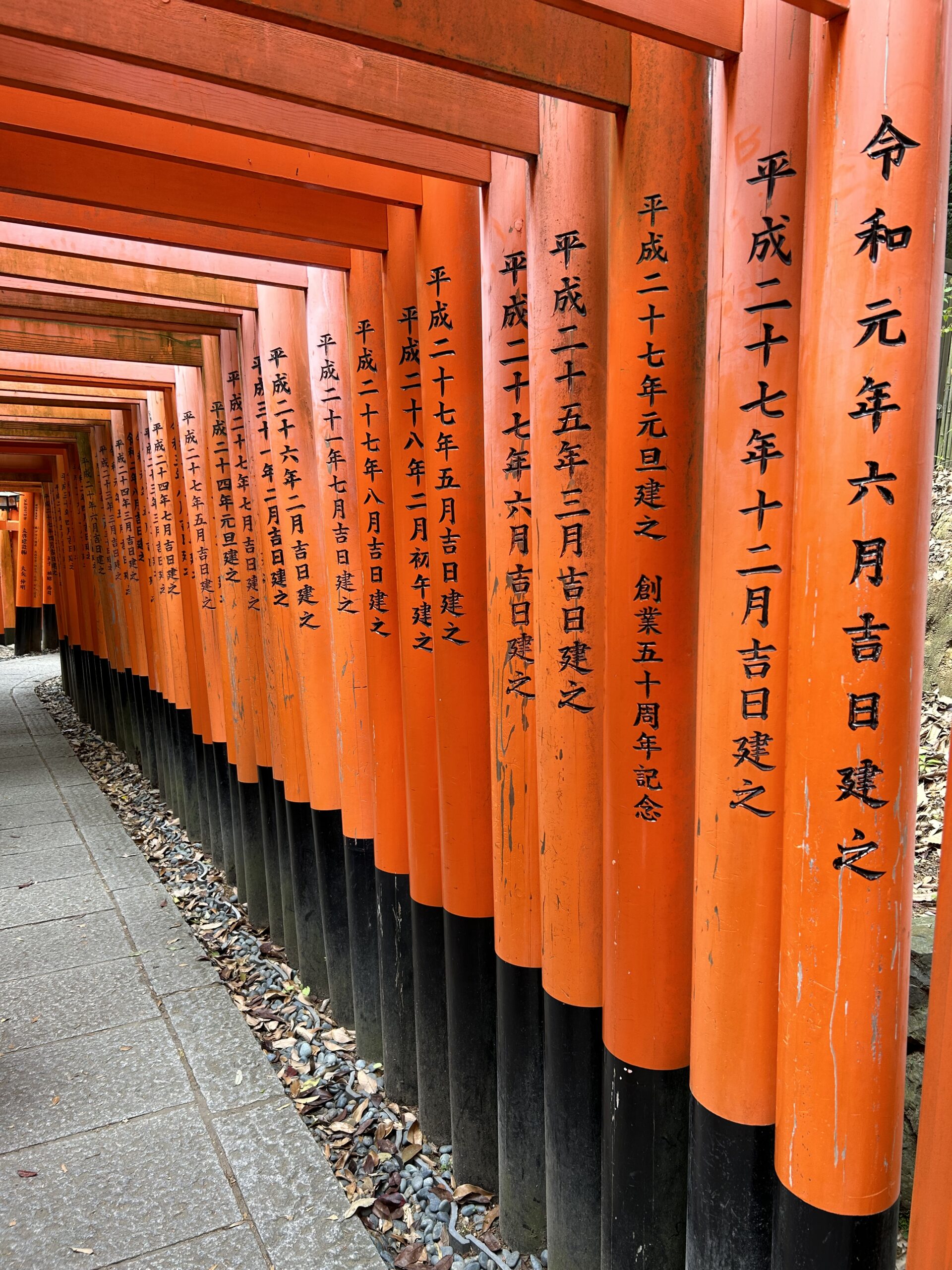
Leave a Reply